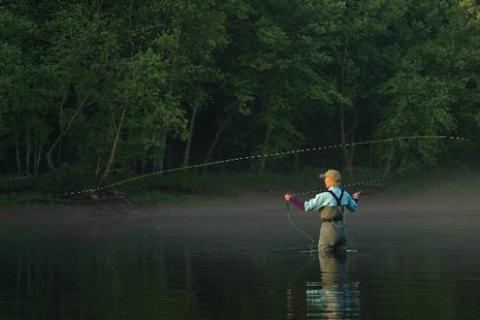
Modern anglers are lucky. The days of heavy, ill-fitting fishing waders are long gone. Those relics, which cracked with age and bathed you in sweat every minute you wore them, have been replaced by models designed with true comfort in mind.
Now waders come in a variety of materials, sizes and styles. You can spend a little or a lot and still find a set suited to the type of fishing, climate, season and waters you frequent. With that in mind, here are a few things to consider when purchasing your next set of waders.

to wade deepest and are
most popular with river
and stream anglers.
1. How & Where Will You Use Your Waders?
First, you won't find any single set of waders ideal for all conditions. Those heavy-duty neoprene chest waders that are just the ticket for early season steel-heading will probably cause you to overheat in the summer when wading for smallmouth bass on your favorite river. Similarly, those light hip waders will not do as well as chest waders on all but the shallowest summer creeks. So, if you value comfort, you might need to purchase more than one pair to get you through the angling season.
The question to ask then is how and where will I use these waders? Spring and autumn use, for instance, demands an insulated pair of waders in all but the warmest waters. In summer, something breathable and lightweight might be all that's needed. And if the waters you are fishing require deep wading, you can rule hip waders out.
Waist-high or pant waders like Simms Freestone Stocking-Foot are, of course, a compromise between the two, allowing you to wade as deep as most anglers are comfortable with, without wearing a short fly fishing vest.

of course, a compromise
allowing you to wade as
deep as most anglers
are comfortable with.
Of course, there is more to it than that. Materials and quality are two other considerations.
2. Understanding Wader Materials
There are four major types of material from which to choose: rubber, canvas, neoprene and breathable materials, such as GORE-TEX. Each material has its unique advantages and drawbacks.
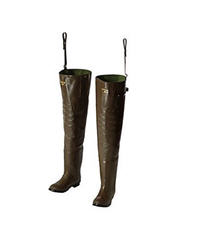
streams and creeks. They're perfect
on hot summer days when you don't
want to wet wade and the best of
them can easily be packed in to the
water you are fishing. Of all the
wader styles, these are the least
expensive too.
Rubber boot waders like the White River Fly Shop waders are heavy, stiffer and less comfortable. They lack breathability, too, meaning that when you sweat, it has nowhere to go since the material seals moisture in. And, make no mistake, wear rubber waders and you'll sweat a lot.
On the plus side, rubber waders are easy to patch, tough and, because they are relatively inexpensive, you don't cry too much when they've finally worn out. For anglers on a budget or who only wade occasionally, they can be a fine choice.
Canvas fishing waders have characteristics similar to rubber, but with added toughness. They can also be stiffer, warmer and a bit heavier, depending on how well they are insulated. Typically, they'll last longer than waders made from the other three materials, too.
They really come into their own when you are fishing brush-choked waters where potential punctures are around every bend. These are also the waders of choice, if they are to be used for double-duty in the duck bind.
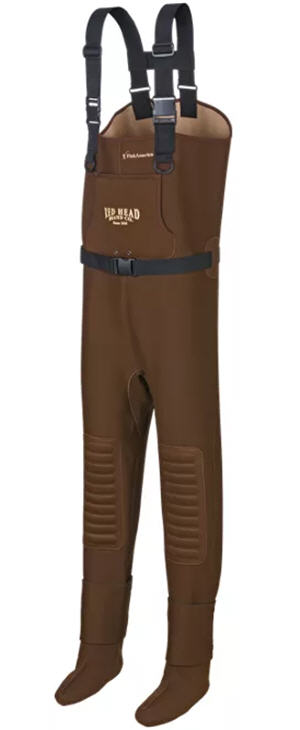
Brown Neoprene Waders
Neoprene waders is, without a doubt, the most popular wader material today. This is essentially the same stuff wetsuits are made out of. They come in a range of thicknesses from around 3.5 to 5 millimeters or better. The greater the thickness of the wader wall, the greater is the insulation, weight and durability too. Repairs are not difficult with the patches typically provided or Aqua-seal or other leak-stopping products. If you want warmth and don't mind sweating, neoprene is a great choice.
Last, but certainly not least, there are breathable waders. These are, as a rule, lightweight and comfortable. As the name implies, they wick away sweat, which means you aren't damp at the end of the day. A quality pair of breathable waders is more expensive, but you are paying for a comfort level and lighter weight not found in other wading materials.
Breathable waders are not really designed with truly cold weather in mind, but when worn with wading pants or additional base layers, an angler can do just fine in the cold water flows of spring, winter and autumn.
3. Choosing the Best Wader Style for Your Needs
Once you've determined the season and type of material that best suits your wading needs, it's time to determine what configuration is best for you — chest or waist-high.
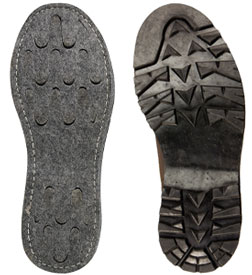
How many wading options you realistically have, however, is dependent on the waters you fish and this is something you should consider. For instance, in some places, raging currents make it very dangerous to fully utilize chest waders — stepping deep in such flows could sweep you away. So, in situations like this, is there a real benefit in chest waders? Only you can decide.
Personally, if I were given the option of only choosing one type of wader, chest waders would win hands-down. Though they might be heavier and less appropriate on hot summer days, they also provide you with more options - and that's always a good thing.
4. Picking Wading Boots
If you choose waist-high or chest waders, you also have the option of buying stocking-foot waders or boot-foot waders.
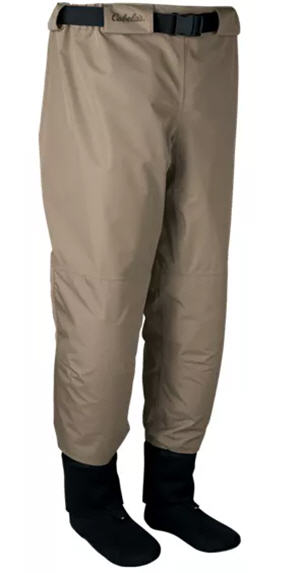
Stocking-foot waders require the angler to purchase wading boots or shoes to go overtop the wader's stocking foot. This means that you can find footwear that's not only comfortable but suited to different conditions. For instance, felt bottomed wading boots are great on slick surfaces, while studded bottoms help grip on mud and rocks. Rubber outsoles are easier to clean. Easier cleaning means you have less chance to cross contaminate or introduce potentially harmful species into new waters, and that's a real consideration if you fish many different waters.

for Ladies
So, while wading boots or wading shoes are a bit of an added expense, they provide the option of having the right tread for different waters, if you buy more than one pair. And boots are transferable from stocking foot wader to wader if you've got more than one pair.
5. Examine the Wader Features
Those are the major considerations in choosing fishing waders, but there are others as well. First, make sure that the suspenders or belt loops (on hip waders) are of a quality design and are comfortable. Next, on chest or waist-high waders ensure that you've got a good cinch belt to stop water from coming in over the top should you go under. This is a critical safety consideration.
You might also want to purchase a quality wading staff too, especially if you routinely fish in strong currents.
The Bottom Line on Fishing Waders
The bottom line is that the right set of waders can keep an angler dry and comfortable. But an inappropriate pair can contribute to a miserable day in the water. Choose your next pair carefully with the waters and season you are fishing in mind and you'll stay high and dry.
- 110737 views

